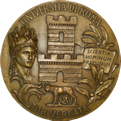FUNDAMENTALS OF CHEMISTRY - 9 CFU
Roberto Paolesse
Teaching Assistant: Dr. Larisa Lvova
 Structure of the Atom, Schrödinger wave equation, Hydrogen atom, Atomic orbitals, Electron Configuration, Periodic Properties and the Periodic table of Elements. Chemical bond: Octet rule, Ionic bond, Covalent bond, Multiple bonds, Lewis electron dot formula, Polar covalent bond, Electronegativity, Valence bond theory, Hybridization, VSEPR theory, Molecular orbital theory, Application of MO theory for diatomic molecules, Forces of attraction between molecules. Structure of the Atom, Schrödinger wave equation, Hydrogen atom, Atomic orbitals, Electron Configuration, Periodic Properties and the Periodic table of Elements. Chemical bond: Octet rule, Ionic bond, Covalent bond, Multiple bonds, Lewis electron dot formula, Polar covalent bond, Electronegativity, Valence bond theory, Hybridization, VSEPR theory, Molecular orbital theory, Application of MO theory for diatomic molecules, Forces of attraction between molecules.
Law of chemical combination, Law of combining volumes, Mole concept, Formula. Stoichiometric Calculations. Gases: Gas Laws, Ideal gas law, Dalton's law of partial pressure, van der Waals equation. Thermochemistry, Heat, Work, First law of thermodynamics, Enthalpy, Entropy, Free energy. Solid and Liquid States, Types of solids, Phase change: vapor pressure. Non-Electrolytic Solutions, Raoult's law, Deviation from Raoult's law, Henry's law, Colligative properties. Chemical equilibrium. Le Chatelier’s principle. Equilibrium constants. Law of mass action. Volume dependency, Temperature dependency, Equilibria in aqueous solutions, Electrolytic dissociation. Colligative properties of electrolyte solutions. Acids and bases, Bronsted-Lowry concept, Lewis concept, Ionization of Water, Acid-base equilibria and pH. Buffers, Solubility product. Oxidation numbers. Redox reactions. Electrochemical cells.
Reference book: Raymond Chang, “General Chemistry: The Essential Concepts”, McGraw-Hill.
Teaching activities: Lessons. Collective tutorial by correcting written exercises.
ENGINEERING ECONOMICS - 6 CFU
Silvia Testarmata (2012-2013)
Brunelli Sandro (2013-2014)
Andrea Fronzetti Colladon (2014-2015)

This course introduces the foundations of microeconomics and investment analysis.
Detailed information about the course are available at:
http://eec.andreafc.com
Text books: Pindyck, R., & Rubinfeld, D. Microeconomics (7th ed. or newer). Prentice Hall International.
Thuesen, G. J., & Fabrycky, W. J. Engineering Economy (9th ed.). Prentice Hall International.
FUNDAMENTALS OF COMPUTING - 9 CFU
Vittoria De Nitto

Introduction to Computer Science, Programming and Media Computation; Basic concepts of programming languages and their implementation in the MatLab language: Variables; Control structures (Loops, Conditional Selection), Data structures and their application to media editing; Functions and parameters; Principles of software design: Designing Programs Top-Down; Designing Programs Bottom-up; Texts, Files, Networks, Databases; Functional Programming; Recursion; Principles of Object-Oriented Programming
Text book:David M. Smith, "Engineering Computation with MATLAB", (3rd edition) Pearson, 2013
Other references provided by the teacher
LINEAR ALGEBRA AND GEOMETRY - 9 CFU
Giuseppe Pareschi

In this course the student will be led to an understanding of basic linear algebra by emphasizing the geometric significance of the subject. The main topics will be: matrices, linear maps, determinants, inner product spaces, systems of linear equations, eigenvalues, self-adjoint linear operators and quadratic forms.
Such concepts will be initially studied within the familiar geometry of the plane and of the three-dimensional space, and, afterwards, in the setting of finite-dimensional inner product spaces.
Syllabus
MATHEMATICAL ANALYSIS I - CFU 12
Fabio Ciolli

Lecturers: Fabio Ciolli, Teresa D’Aprile
Tutor: Aleks Jevnikar
Differential and integral calculus for real functions: real and complex numbers; elementary real functions and their inverse: polynomial, exponential, logarithm, trigonometric etc.; concept of limit, limits of indefinite forms; continuity, properties of continuous functions, uniform continuity; derivatives, maxima and minima, the graph of a function; De L 'Hopital's Rule; Taylor expansions; antiderivatives, integrals; improper integrals; series; elementary differential equations of first and second order. Introduction to multivariable calculus: continuity; differentiation, directional derivatives, gradient; higher order differentiations, Hessian matrix.
Textbook: Tom M. Apostol: Calculus Vol.1, second edition; John Wiley & Sons, (1974).
Claudio Canuto, Anita Tabacco: Mathematical Analysis I-Springer International Publishing, UNITEXT 84, (2015).
Syllabus
PHYSICS I - CFU 12
Maria Richetta
 Scientific method. Kinematics of a point particle. Relative motion. Newton's laws. Harmonic oscillator (simple, damped and forced). Dynamics in non-inertial systems. Work, energy, power. Central forces. Moments and equilibrium of moments. Dynamics of particle systems. Statics and dynamics of rigid bodies. Introduction to thermodynamics. 1st law of thermodynamics. 2nd law of thermodynamics, entropy, probability. Scientific method. Kinematics of a point particle. Relative motion. Newton's laws. Harmonic oscillator (simple, damped and forced). Dynamics in non-inertial systems. Work, energy, power. Central forces. Moments and equilibrium of moments. Dynamics of particle systems. Statics and dynamics of rigid bodies. Introduction to thermodynamics. 1st law of thermodynamics. 2nd law of thermodynamics, entropy, probability.
Kinetic theory of gases, statistics. Gibbs and Helmholtz free energies. Elastic waves. Huygens principle, reflection and refraction. Statics and dynamics of fluids.
|

 Structure of the Atom, Schrödinger wave equation, Hydrogen atom, Atomic orbitals, Electron Configuration, Periodic Properties and the Periodic table of Elements. Chemical bond: Octet rule, Ionic bond, Covalent bond, Multiple bonds, Lewis electron dot formula, Polar covalent bond, Electronegativity, Valence bond theory, Hybridization, VSEPR theory, Molecular orbital theory, Application of MO theory for diatomic molecules, Forces of attraction between molecules.
Structure of the Atom, Schrödinger wave equation, Hydrogen atom, Atomic orbitals, Electron Configuration, Periodic Properties and the Periodic table of Elements. Chemical bond: Octet rule, Ionic bond, Covalent bond, Multiple bonds, Lewis electron dot formula, Polar covalent bond, Electronegativity, Valence bond theory, Hybridization, VSEPR theory, Molecular orbital theory, Application of MO theory for diatomic molecules, Forces of attraction between molecules.



 Scientific method. Kinematics of a point particle. Relative motion. Newton's laws. Harmonic oscillator (simple, damped and forced). Dynamics in non-inertial systems. Work, energy, power. Central forces. Moments and equilibrium of moments. Dynamics of particle systems. Statics and dynamics of rigid bodies. Introduction to thermodynamics. 1st law of thermodynamics. 2nd law of thermodynamics, entropy, probability.
Scientific method. Kinematics of a point particle. Relative motion. Newton's laws. Harmonic oscillator (simple, damped and forced). Dynamics in non-inertial systems. Work, energy, power. Central forces. Moments and equilibrium of moments. Dynamics of particle systems. Statics and dynamics of rigid bodies. Introduction to thermodynamics. 1st law of thermodynamics. 2nd law of thermodynamics, entropy, probability.